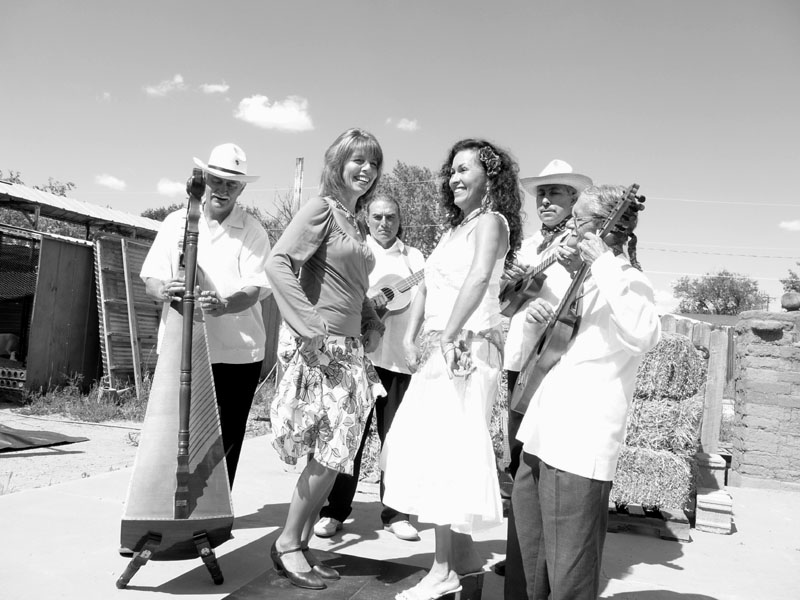

|
Los Jaraneros del Valle Build Musical Bridges with Son Jarocho


|

Los Jaraneros del Valle
Victor Padilla uses engineering terms to describe the musical goals of Los Jaraneros del Valle: "We started out to find bridges built long ago with Mexico instead of the walls which, unfortunately, are now going up. We found the vigas of a musical bridge and we are re-constructing it." Based in Albuquerque's South Valley, Los Jaraneros are - besides founder Victor Padilla - Felipe Lucero, Antonio Aragon, Teresa Slack, Rafaelita Gonzales, Lorenzo Candelaria and Ricardo Maes. They perform every Friday morning at La Placita Café on Isleta Boulevard, in the heart of Albuquerque's Mexican and Latin American immigrant community, and they are being featured regularly at local arts fests and other venues. A CD is in preparation and they have tracks on a recent anthology of New Mexico music.
Building Musical Bridges with Son Jarocho by Bill Nevins
Los Jaraneros' bridge is son jarocho, a folk music style until recently little heard in New Mexico, where the ranchera, norteno and mariachi styles of Texas and Chihuahua are more evident. Son jarocho originated centuries ago far from El Norte, in the balmy Gulf coastal region of southern Veracruz, where the annual late January Fiesta de la Candelaria showcases regional poetry and son jarocho. This music is the complex heritage of a transcontinental cultural journey, linking African influences with European and Native American styles, instrumentation and outlook. Los Jaraneros draw their group name from the jarana, a small guitar-type instrument with five strummed courses of strings, several of them doubled - the rhythmic heartbeat of son jarocho. Against this, Victor's or Lorenzo's arpa jarocho (Mexican folk harp) delivers arpeggios over a syncopated bass pattern on la liona (bass guitar). Meanwhile, Victor improvises melodies on his four-string requinto guitar, plucked with a bull-horn pua (pick) as additional percussion is provided by the cajon (wooden box) and dancer Teresa's staccato heel-strikes on la tarima, a small dance platform. Singing (in Spanish) alternates among all members of the group, with short choral responses following a lead singer. There is much improvisation, as jarocho musicians claim they never perform the same son exactly the same way. The overall effect is exhilarating! Son, of which there are several regional types in Mexican music, originally denoted the "noise" (son) of the people, as contrasted to the "dignified" music of the Church. Son jarocho is characterized by a 6/8 rhythm syncopated with 2/4 and 3/4 rhythms (sesquialtera) and the staccato heel dance (zapateado). It links Spanish fandango and theatrical song styles with Native American influences and the African-originating music of slaves and free Blacks, particularly the call-and-response element and note-bending also found in work songs, spirituals and blues. Irreverent was the original meaning of the term jarocho, and witty sarcasm has become a matter of pride among the musicians and people of southern Veracruz, many of whom are African-Mexicans who historically asserted themselves despite being outside the framework of mainstream Mexican society. This attitude bothered the colonial Church so much that it tried to suppress son jarocho for its "devilish qualities" of frequent sexual doble sentidos (double meanings) and a tendency to make fun of death, sorrow and the Church itself. "Devil's music" or not, son jarocho is entrancing, focused in compas-- harmonic and rhythmic phrases repeated throughout each piece and within which the musicians improvise. You've heard it in the song "La Bamba" and in Ozomatli's jarocho-flavored rock. Mexican style "trance blues", if you will, which pulls listeners in, smiling and moving their feet. Victor Padilla, an Albuquerque native and lifelong "chicano guitarist", first encountered son jarocho up close on a visit to Tlacotalpan, Veracruz in 1996 when he met Ramon Gutierrez-Hernandez, founder of the internationally famed group Son de Madera, and a leader, with his brother Gilberto Gutierrez- Silva, of the modern roots-revival of son jarocho. Son de Madera have taken this rural Mexican music around the world, appeared in films including the fascinating documentary The Third Root (about cultural interaction among musicians in Mexico and Morocco), and recently appeared with Los Angeles trad-rockers Quetzal at National Hispanic Cultural Center. Victor credits Ramon with inspiring the emergence over the last three decades of major son jarocho bands like Mono Blanco in Mexico, Tenocelomeh in California, La Tuza in Boston-and, of course, Albuquerque's own Los Jaraneros. Victor and other members of Los Jaraneros, following the apprenticeship tradition of son jarocho, study under the guidance of Maestro Oti Ruiz, the great Veracruzano harpist who now lives in Albuquerque and teaches music in Bernalillo. Victor speaks in reverent terms of Oti Ruiz, adding with a smile, "Oti says I am his bridge to the US, but the truth is that it is a two-way bridge!"Lorenzo Candelaria adds his hope that local fans and students of son jarocho will join with arts organizations to bring masters of this art to New Mexico for workshops and performances in coming years. Lively, addictively danceable, irreverent-- the music of Los Jaraneros and their compadres in son jarocho strengthens joyful bridges among peoples and slyly winks at sadness. - Bill Nevins Los Jaraneros may be contacted at (505) 563-0910 or (505) 263 6554. Photo by Priscilla Baca y Candelaria ([email protected]) |